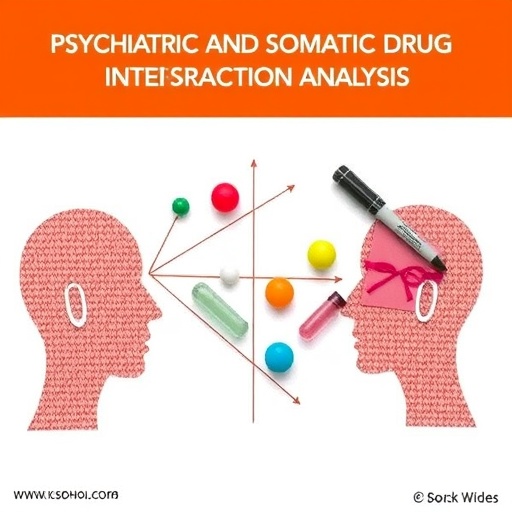In recent years, the complex interplay between psychiatric medications and somatic drugs has garnered increasing attention within clinical pharmacology. Psychiatric patients often experience multiple coexisting physical health conditions, demanding polypharmacy approaches that heighten the risk of adverse drug interactions. A groundbreaking study published in BMC Psychiatry in 2025 delves into this critical issue by analyzing spontaneous adverse drug reaction (ADR) reports from the European ADR database, EudraVigilance. This study paints a revealing picture of the persistence of well-known drug-drug interactions (DDIs) between psychiatric therapeutics and somatic medications, underscoring ongoing clinical challenges.
The research team utilized 9,276 ADR reports submitted between 2017 and 2021 that involved antidepressants, antipsychotics, and mood stabilizers as either suspected or interacting agents. By leveraging ABDATA, a drug information system specializing in known potential DDIs (pDDIs), the investigators systematically identified instances where psychiatric medications may have adversely interacted with treatments for somatic conditions. Their objective was to gauge whether these interactions, already documented in pharmacological knowledge bases, continue to manifest in real-world clinical scenarios despite heightened awareness.
Importantly, out of the total reports analyzed, 1,271 cases—nearly half of them—featured 2,655 instances of potentially interacting drug pairs. These interactions encompassed 728 different combinations of psychiatric and somatic drugs, illustrating a highly heterogeneous landscape of pharmacological risk. Notably, patients involved in reports containing pDDIs were statistically older, with a median age of 64 compared to 49 years for those without such interactions. This age-related trend aligns with existing evidence showing that older individuals, often burdened with multiple comorbidities, are more vulnerable to complex medication regimens.
Moreover, the frequency of pDDIs and the number of drugs administered rose steadily with patient age, highlighting the escalating complexity of managing pharmacotherapy in elderly populations. The intersection of aging, polypharmacy, and psychiatric illness emerges as a critical nexus necessitating enhanced clinical vigilance. Through detailed individual assessments within the ADR reports, the study authenticates the occurrence of adverse effects linked to these drug pairs, dispelling any presumption that detected pDDIs remain theoretical or avoidable in practice.
Among the most frequently identified interactions were those leading to hyponatremia, predominantly involving antidepressants combined with diuretics. This electrolyte imbalance carries severe clinical implications, including increased risks of cognitive impairment, falls, and even mortality, particularly in frail elderly patients. Of the assessed reports, 7.6% confirmed the presence of hyponatremia, marking a significant clinical consequence directly associated with these drug combinations.
Another major safety concern was bleeding events related to selective serotonin reuptake inhibitors (SSRIs) used concomitantly with antithrombotic agents such as platelet aggregation inhibitors, anticoagulants, or non-steroidal anti-inflammatory drugs (NSAIDs). The study revealed bleeding complications in a sizable fraction of cases—ranging from 17.4% to 33.3%—depending on the specific interacting somatic medication class. These findings reinforce the delicate balance clinicians must maintain when managing psychiatric conditions in patients who require antithrombotic therapy.
The persistence of these interactions, despite their presence in drug information systems and clinical guidelines, flags significant gaps in medication management. These findings indicate that awareness alone does not suffice to mitigate DDI risks; proactive monitoring strategies and tailored interventions are urgently needed. This is particularly vital for the growing demographic of elderly psychiatric patients, who are disproportionately affected by polypharmacy and its complications.
The study’s robust methodology, relying on spontaneous ADR reporting and comprehensive drug interaction databases, offers valuable insights but also underscores the limitations inherent in passive surveillance systems. Underreporting and variability in data completeness may underestimate the true burden of DDIs in psychiatric pharmacotherapy. Nonetheless, the data convincingly confirm that recognized interactions translate into tangible patient harm, reinforcing the clinical imperative to integrate drug interaction checks into routine care workflows.
Clinicians are thus called to exercise heightened caution when prescribing psychiatric medications alongside somatic treatments known to interact adversely. This includes judicious selection of therapeutic agents, vigilant monitoring for early signs of interaction-related adverse effects, and patient education to recognize and report symptoms promptly. Pharmacists and multidisciplinary teams can play pivotal roles in optimizing medication regimens and mitigating risks.
In parallel, this study signals a pressing need for continued research and innovative tools that enhance the detection, prevention, and management of DDIs in psychiatric patients. Advances in electronic health records incorporating automated interaction alerts, coupled with personalized risk assessment models accounting for patient age, comorbidities, and polypharmacy, may substantially improve clinical outcomes.
Ultimately, this investigation from EudraVigilance fortifies our understanding that drug-drug interactions in psychiatric care are not relics of the past but prevalent realities demanding rigorous attention. By translating these findings into actionable clinical strategies, healthcare systems can better safeguard vulnerable psychiatric populations from preventable adverse drug events, thereby enhancing both the safety and efficacy of mental health treatments.
Subject of Research:
Article Title:
Article References:
Dubrall, D., Weber, R., Böhme, M. et al. Analysis of drug-drug interactions in spontaneous adverse drug reaction reports from EudraVigilance focusing on psychiatric drugs and somatic medication. BMC Psychiatry 25, 914 (2025). https://doi.org/10.1186/s12888-025-07352-8
Image Credits: AI Generated
DOI: https://doi.org/10.1186/s12888-025-07352-8




